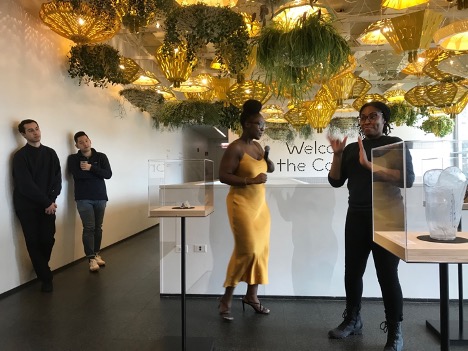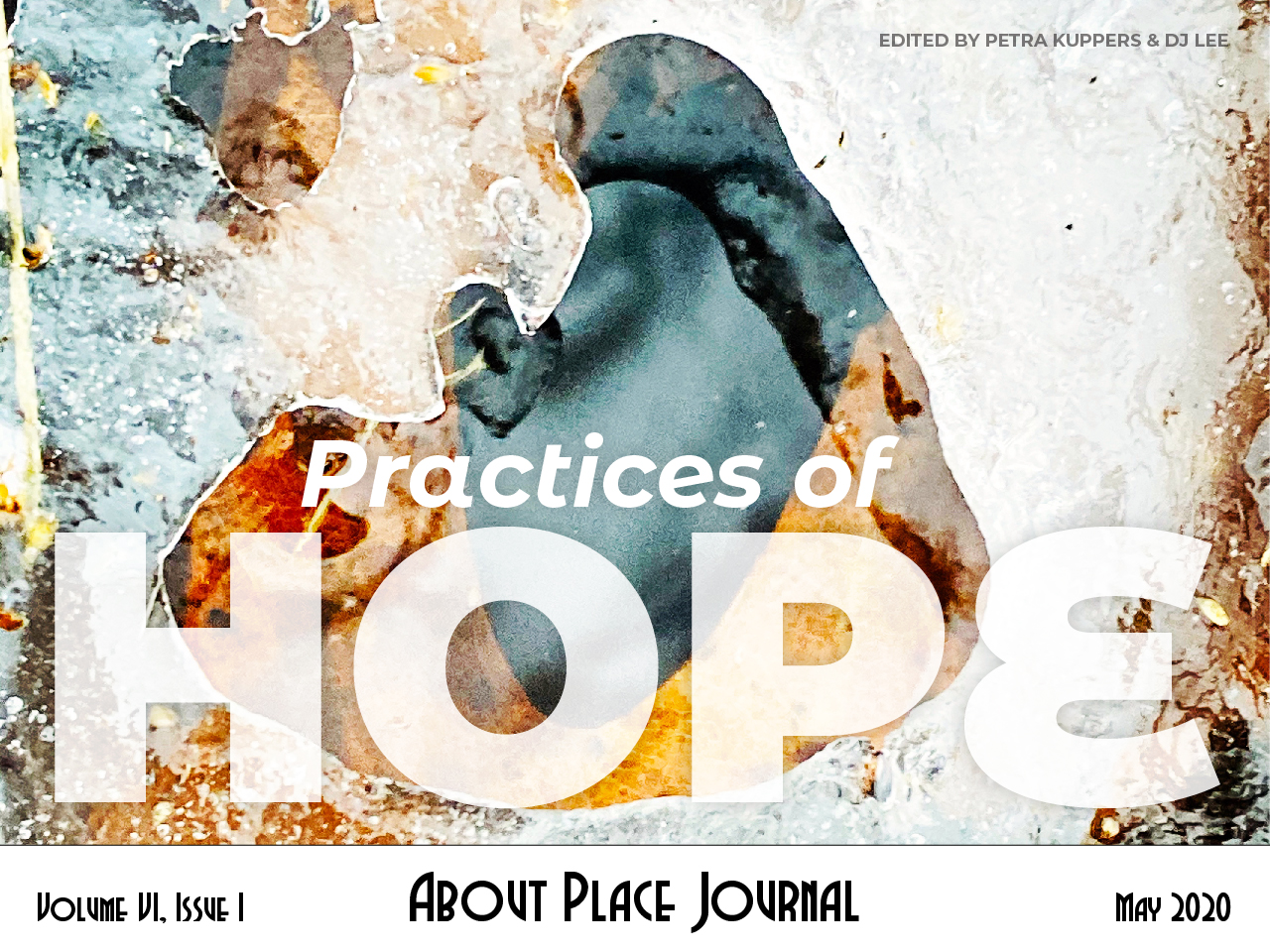Editor’s Letter – Part 1: February 2020
I started the first part of this letter in February 2020. My co-editors and I had been steeped in About Place submissions for nearly two months, reading our way through nearly 2000 epistles from all kinds of Practices of Hope. Much became clear quickly: our editorial collective valued a sense of humor, we responded to surreal subversion, and we enjoyed inter-media play. Also, for those months of editing, our own embodied perspectives shifted, with new attentions opening up new paths. Let me take you on one of these journeys.
Today, I rolled on my scooter through Chicago, visiting with the Museum of Contemporary Art (MCA), to see disability culture in action. It’s a day of sharing: I am curious to find out what curator Adero Knott has put together in her Disability and Perspective exhibit, based on conversations with disabled Chicagoans, and their offerings of what should be stored in their contemporary art museum to speak about their lives and their everyday creativity.
This exhibit is inside the MCA’s Commons area, and shares space with another exhibit: With Love from the Tropics, a hanging garden of gold and green that suspends from the ceiling above the art exhibit cubes, 221 planters full of hardy indoor plants, plus lamps, chairs, tables. Here is how the creators of this environmental installation, Mexico City–based architecture firm Pedro y Juana (Ana Paula Ruiz Galindo and Mecky Reuss), present their work: “The work subverts the reality of Chicago’s harsh climate in the city by bringing the summer indoors year-round and disrupts the traditional austerity of the museum space, welcoming the visitor with color, humor, and a sense of play.” (from the MCA website).
Art enables art, enables publics, enables commons, enables art: this is the circuit I am watching at play here, a spatialized Practice of Hope. Of course, even the presence of playful plants cannot easily lure Chicagoans who do not feel ownership of the MCA: the crowd on the lovely wintery Saturday afternoon is multi-racial, but mainly consists of students, a significant and important aspect of the museum’s clientele and place in the community.

I note how few people in the room look or otherwise signal as disabled themselves. Class and access are hard barriers for artistic participation, even when the art exhibits are deeply human-shaped and accessible to many. Space rules do not easily break up, and are created by long histories of racialized, gendered, ableist and classist divisions.
Plants serve here as commons markers, as openings, as invitation. They work to soften the edges, to creep around corners, to find holds in tiny spaces, to dampen the echoes. Do they thrive here? I am not sure. Many planters are empty.
Here are Practices of Hope. I walk among them. I speak with them: artists who create beauty in hard times. Adero Knott herself has a prosthesis development business, as she found that she had a hard time finding an arm prosthesis that would work with her dark skin-tone: she wants POC disabled folks to have access to beauty in their own right, not build on racist notions of what the ‘standard’ human skin tone looks like.
In the pages of this journal, you will find many such Practices of Hope, often as commentary on past and present violences: some playful, some somber, some strangely planted off-shoots of familiar tales, shifting standards one word at a time.
We honor the creative and world-tending work of curators, shapers, opportunity-makers, and editors. As a result, we have entries like “Sunvaulting” by Phoebe Wagner and Brontë Wieland, a meditation on the process of publishing their 2017 collection Sunvault: Stories of Solarpunk and Eco-Speculation, and on where solarpunk is coming from and going. We also have a connection to Our Entangled Future, an anthology of climate fiction, by Karen O’Brien, Ann El Khoury, Nicole Schafenacker and Jordan Rosenfeld, published out of the AdaptationCONNECTS ResearchProject, University of Oslo, Norway.
Sometimes, our contributors reference important collectives as touch-stones: Shaya French, for instance, builds her story as an homage to Alexis Pauline Gumbs’ “Evidence,” from Octavia’s Brood: Science Fiction Stories from Social Justice Movements, by editors adrienne maree brown and Walidah Imarisha, a ground-breaking collection of activist/artists that has stood as inspiration to us.
Editor’s Letter – Part 2: end of March 2020
We finish the editing process in a changed world: no more gatherings for now, I am ‘sheltering in place’ in Michigan, on day 27 of isolation after I fell sick on March 3rd 2020, out of it all with fever and cough for two weeks. All shows, productions, reading gigs and exhibit visits are called off for the months ahead. We have to reinvent both socializing and art sharing, and by the time you read this, after May 1st, our release date, our social worlds will have shifted even more, under viral assault and economic reinvention pressures.
As a disabled woman, I have had to alter my life routines quite a few times over the years, and many people in my wider disability culture networks have solid structures for shifting paths when our bodyminds and the wider shared world are not in rhythm. But it is hard. I miss hugs, I miss dancing together, and I miss my warm-water therapy pool. But spring is here, and green shoots emerge in the gardens.
This editing process, communicating with many artists in this issue, has been one of the lifelines of this past month. I have found comrades who work in the aftermath of viral lives (Marc Arthur, and his futurist Detroit, an AIDS infection fantasy where the virus has a new valency field) or who look for new out-of-space living in a white supremacist world (Syrus Marcus Ware, and his vision of a future Antarctica settlement). Hong-Kong based performance artist Kanta Kochhar-Lindgren calls us to a practice of “the house on my back,” re-inventing The Tempest within an Afro-Asian futurism of migrations and connections.
There will be opportunities for new kinds of growth, a shifting of goals and perspectives on capitalism, climate catastrophe, and the ability of the world population to respond to pressures. We can pool resources, ground ourselves in respectful practice, learn from each other. Margaret Noodin writes in Anishinaabemowin and English, and roots herself in Ojibwe land and language:
This place remembers us
ishkwaa nishinaadendamang
after we fall apart
noojimo’idizoyang.
and put ourselves back together.
Let’s dream, create, find joy and new connections in Practices of Hope.

